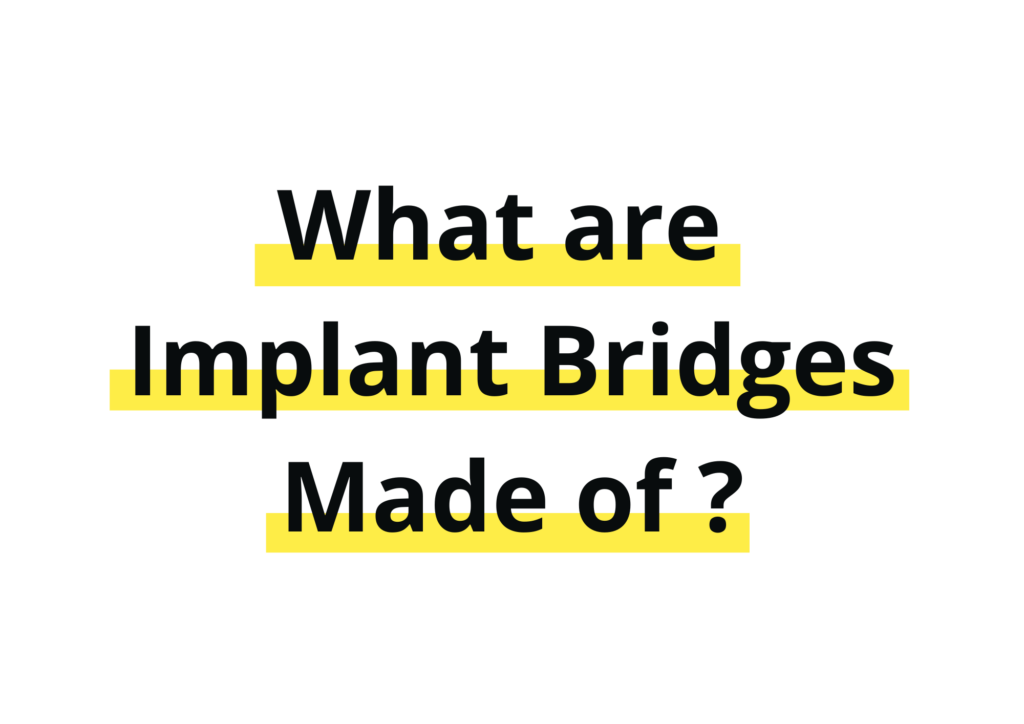

By Leanne.
Share article:
A Fixed Implant Bridge or Full Arch Prosthesis is supported by four or more implants (usually titanium) in the upper Maxilla or lower Mandible (or both) to restore a complete arch of missing teeth.
Your implants, if well taken care of, should last your lifetime. The Prosthetic Arch, however, may need replacing at some stage.
Let’s look at the most common materials used to make the implant bridges, their strength ratings and how long they ‘should’ last… if you’re not Fred or Barney, that is!




The technical stuff: Stay with me now!
- A megapascal (MPa) is a measure of pressure.
- Flexural strength tells the maximum amount of pressure a material can take.
- Modulus of rupture? It sounds like something from a romance novel!
- Shearing failure, tensile strength, compression strength, Fatigue…
These terms are all important when it comes to materials used, as they must withstand force and stress and resist bending failure.
All manufacturers of materials used in the dental industry provide MPa values that indicate their strength. One thing to note is that these figures come from self-reporting data. Therefore, flexural strength alone isn’t the only comparison between materials, but it gives a way to compare some of the most commonly used.
Common Materials used in the production of Fixed Implant Bridges are:
Acrylic (plastic) = 100 MPa Cost $
It’s easy to repair. It is made with a liquid resin in a mould. A heat curing process is used to wrap around a titanium bar in permanent bridges, and thicker bulkier material is used in temp bridges with no bar support. It should last 5 years or more.
Pros: It is easy to fix if it breaks or chips, can be repaired chair-side, and is cheaper to make. No clinking sound when teeth touch.
Cons: Food tends to stick more. It’s porous, so stains easier, especially with coffee and red wine. It can retain odours and can scratch easily if using an abrasive toothpaste or a stiff toothbrush. Accumulates bacteria over time.
PMMA (Polymethyl Methacrylate) = 110 MPa. Cost $.
It is milled from a puck. It will last 5 years, probably longer.
Pros: Milled in one piece (monolithic). A hybrid bridge involving acrylic teeth with a titanium bar, less bulky, can be used in a final or permanent bridge. Reduced risk of fracture. Easy to repair chair-side.
Cons: Less porous than acrylic, but can still stain, can scratch if abrasive paste or brushes are used.


3D printed arch = 135 MPa Cost $.
A newer product, robust and elastic at the same time. Highly aesthetic one-phase material with perfectly matched opacity. Longer durability and high wearing comfort. Unknown duration as a new product, expected 3-5 years +
Pros: 3D Printed, made to precise design, easy to repair, no clinking sound when teeth touch. Easy to repair.
Cons: Porous and can stain easier, can scratch if abrasive toothpaste or brush is used.


Graphene. Nano-reinforced biopolymers = 150 MPa Cost $
It’s PMMA laced with carbon graphene; therefore, it’s stronger. Less staining, it’s antimicrobial & antibacterial and easy to repair. New material, duration five years +
Pros: Milled in one piece with a titanium frame, digitally designed for a perfect fit. Easy to repair if it breaks or chips.
Cons: Unknown duration as a new product, expected 5 years +


Nano-ceramics. Brand name Crystal Ultra, = 490 MPa Cost $$
Pros: up to 60% lighter than Zirconia, non-staining, non-porous, longer lasting, lighter in weight & can be repaired chair-side. It has flex when paired with a Trilor bar, so there is less pressure on implants. Highly aesthetic.
Cons: expensive, unknown duration, expected 10 years +

Porcelain = 300 MPa Cost $$$
Pros: Highly aesthetic, non-staining, used for Veneers and single crowns, arches can be made with no pink gum for patients with no underlying gum disease/issues. Should last 10-15 Years +
Cons: Difficult to repair if it breaks. Not all patients are candidates for a Porcelain implant bridge. Since up to eight implants usually support it, adequate bone must be available. This material is very heavy. $$$
Zirconia, ‘’The Tesla of Teeth’ = 1200 MPa Cost $$$
Pros: More aesthetic than other materials, strongest material. 10 -15 years, possibly longer, non-staining. Less material in the mouth. It can be paired with another material, for example, zirconia upper with a graphene lower arch. Should last 10-15 Years +
Cons: Heavier, noisy, can clink together & difficult to repair, so would need replacing. $$$.


Things to keep in mind:
Different materials have different levels of strength, translucency, opacity & brightness.
The material matters because it will significantly affect the performance, feel, longevity, maintenance, and cost of your new teeth.
With advances in technology, new materials are appearing all the time. Each new product must pass rigorous testing before it can be approved for use by the TGA or FDA. They have to be safe, biocompatible and non-toxic.
Not all products are available or approved for use globally and are subject to change.
Different materials can be suitable for different ages/lifestyles. If you’re 80 and eat a mainly soft diet, acrylic bridges will be fine. If you’re more the rugged type and consuming nuts, jerky and hard, crunchy foods, Zirconia or a Nano-ceramic may be better suited.
- Your age
- Your opposing teeth
- Your oral health
- Bone density & quality
- Your budget
- Reason(s) for tooth loss
- Allergies
- Bruxism (grinding)
- Clenching
And just like with Goldilocks, there is something that’s ‘just right for you.’


Disclaimer: The information provided on this platform, including text, graphics, and images, is intended for general informational purposes only. It is not a substitute for professional dental advice, diagnosis, or treatment. For specific dental concerns, it is crucial to consult with a qualified dental practitioner. They will be able to assess your individual circumstances, provide accurate diagnoses, and offer appropriate treatment options tailored to your specific needs
Print article:
Share article:
Subscribe To Leanne's Blog
Ready for your new smile?


